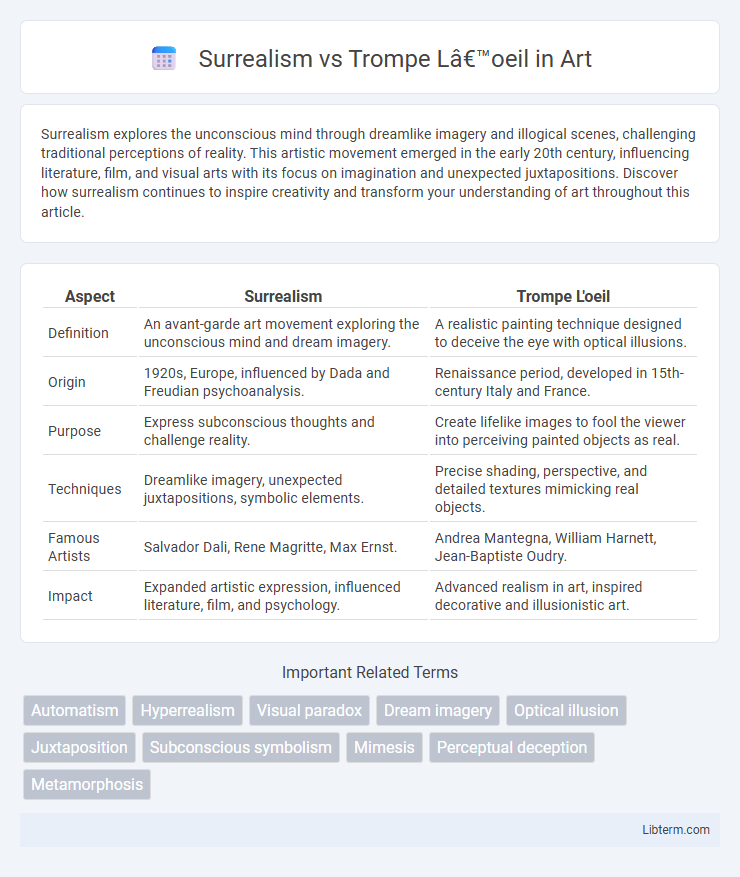Surrealism explores the unconscious mind through dreamlike imagery and illogical scenes, challenging traditional perceptions of reality. This artistic movement emerged in the early 20th century, influencing literature, film, and visual arts with its focus on imagination and unexpected juxtapositions. Discover how surrealism continues to inspire creativity and transform your understanding of art throughout this article.
Table of Comparison
| Aspect | Surrealism | Trompe L'oeil |
|---|---|---|
| Definition | An avant-garde art movement exploring the unconscious mind and dream imagery. | A realistic painting technique designed to deceive the eye with optical illusions. |
| Origin | 1920s, Europe, influenced by Dada and Freudian psychoanalysis. | Renaissance period, developed in 15th-century Italy and France. |
| Purpose | Express subconscious thoughts and challenge reality. | Create lifelike images to fool the viewer into perceiving painted objects as real. |
| Techniques | Dreamlike imagery, unexpected juxtapositions, symbolic elements. | Precise shading, perspective, and detailed textures mimicking real objects. |
| Famous Artists | Salvador Dali, Rene Magritte, Max Ernst. | Andrea Mantegna, William Harnett, Jean-Baptiste Oudry. |
| Impact | Expanded artistic expression, influenced literature, film, and psychology. | Advanced realism in art, inspired decorative and illusionistic art. |
Introduction to Surrealism and Trompe L’oeil
Surrealism, a 20th-century avant-garde movement, explores the unconscious mind through dreamlike, illogical scenes that challenge reality. Trompe L'oeil, a technique rooted in classical art, creates hyper-realistic imagery designed to deceive the viewer's eye into perceiving painted detail as three-dimensional. Both styles manipulate perception but differ fundamentally: Surrealism evokes psychological depth, while Trompe L'oeil emphasizes visual trickery and craftsmanship.
Historical Origins and Evolution
Surrealism originated in the early 1920s as a literary and artistic movement led by Andre Breton, emphasizing dreamlike, irrational imagery to unlock the unconscious mind. Trompe l'oeil, dating back to ancient Greece and Rome but flourishing during the Renaissance, focuses on hyper-realistic painting techniques designed to "deceive the eye" by creating optical illusions of three-dimensionality. Both styles evolved through shifting cultural contexts: Surrealism embraced psychoanalytic theories and avant-garde experimentation, while Trompe l'oeil maintained its roots in classical realism and technical precision.
Philosophical Foundations and Intentions
Surrealism, rooted in the exploration of the unconscious mind, embraces dreamlike imagery and irrational juxtapositions to challenge perceived reality and provoke introspection on human existence. Trompe L'oeil, grounded in classical aesthetics and optical illusion, aims to deceive the viewer's eye by creating hyper-realistic images that blur the boundary between art and reality. While Surrealism seeks to transcend reality through subconscious expression, Trompe L'oeil emphasizes meticulous craftsmanship to replicate and question visual perception.
Visual Techniques and Artistic Methods
Surrealism employs dreamlike imagery and illogical scenes using techniques such as automatism and juxtaposition to challenge reality and evoke the subconscious. Trompe l'oeil relies on hyperrealistic painting methods, including precise perspective, shading, and texture, to create optical illusions that deceive the viewer into perceiving painted objects as three-dimensional. Both styles manipulate visual perception but Surrealism emphasizes imaginative distortion, while Trompe l'oeil prioritizes meticulous realism.
Key Artists and Iconic Works
Surrealism, championed by artists like Salvador Dali with iconic works such as "The Persistence of Memory," explores dreamlike, bizarre imagery that challenges reality and subconscious thought. Trompe L'oeil, exemplified by Jean-Baptiste-Simeon Chardin and William Harnett, employs hyper-realistic techniques in paintings like Harnett's "The Old Violin" to create optical illusions that deceive viewers into perceiving painted objects as real. The contrast between Surrealism's imaginative distortion and Trompe L'oeil's meticulous realism highlights distinct approaches to visual perception in 20th-century art.
Perception, Illusion, and Reality
Surrealism manipulates perception by blending dream-like elements and unexpected juxtapositions, challenging viewers' grasp of reality through subconscious symbolism. Trompe L'oeil employs hyper-realistic techniques to create optical illusions that deceive the eye into perceiving painted objects as three-dimensional and tangible. Both art forms explore the boundary between illusion and reality, yet Surrealism emphasizes psychological depth while Trompe L'oeil prioritizes visual trickery.
Symbolism and Narrative Approaches
Surrealism employs dream-like symbolism and irrational juxtapositions to evoke subconscious narratives, often blurring the line between reality and imagination. Trompe L'oeil emphasizes hyperrealistic detail to create optical illusions, focusing on literal representation rather than symbolic meaning. While Surrealism invites interpretive storytelling through abstract symbols, Trompe L'oeil narrates by deceiving the viewer's perception with meticulous visual accuracy.
Impact on Modern Art Movements
Surrealism revolutionized modern art by exploring the subconscious and dream imagery, influencing Abstract Expressionism and Pop Art with its emphasis on psychological depth and irrationality. Trompe L'oeil, known for its hyper-realistic illusionism, impacted photorealism and hyperrealism movements by pushing boundaries of visual perception and technical skill. Both movements challenged conventional representation, shaping diverse artistic explorations and expanding the definition of reality in contemporary art.
Viewer Experience and Interpretation
Surrealism challenges viewers with dreamlike, illogical scenes that evoke subconscious emotions and invite open-ended interpretation, often blurring reality and fantasy. Trompe L'oeil captivates viewers through hyper-realistic imagery designed to trick the eye, creating an immediate perception of depth and tangible objects that disrupt the boundary between representation and reality. While Surrealism encourages introspection and psychological engagement, Trompe L'oeil emphasizes visual deception and astonishment rooted in technical precision.
Surrealism vs Trompe L’oeil: Comparing Legacies
Surrealism challenged conventional perceptions by merging dreamlike imagery with reality, revolutionizing modern art through its emphasis on the unconscious mind and symbolic complexity. Trompe L'oeil, rooted in hyperrealism, focuses on optical illusion and precision to deceive the viewer's eye, preserving classical techniques and craftsmanship. The legacy of Surrealism lies in its transformative influence on contemporary art and culture, while Trompe L'oeil endures as a testament to technical skill and visual trickery in artistic tradition.
Surrealism Infographic

 libterm.com
libterm.com